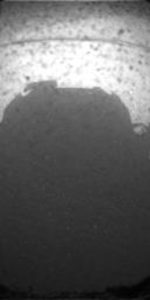
A difficult and daring descent by NASA’s Mars Science Laboratory (MSL) has resulted in a spectacular success by its Sky Crane lander that deposited the 1 ton Curiosity rover on the surface of Mars 154 million mi. from Earth.
The landing followed a flawless and fast paced atmospheric entry using a 14.8 ft. Lockheed Martin heat shield equipped PICA phenolic impregnated carbon ablator on its first Mars entry. This lighter more efficient ablator replaced the SLA-561V material used for all other Mars entries. The heat shield protected Curiosity and the Sky Crane from temperatures of up to 3,500F.

Moments after MSL dove into the atmosphere at 70 mi. altitude and 13,200 mph, it transmitted data indicating that it had shed several hundred pounds of tungsten mass to pitch the aeroshell up where it would generate lift and essentially fly under active guidance to the landing site.
Rob Manning Curiosity chief engineer said the active guidance first commanded the aeroshell into a hard right bank followed by a quick left roll reversal then back to the right again directly onto the centerline to the target area.

Curiosity was deposited so gently on Mars by its Jet Propulsion Laboratory Sky Crane lander, that it took a moment for controllers to check three separate references to confirm the car sized rover was indeed solidly on the Martian surface.
The Odyssey relay spacecraft was heading south to the west of the landing site as the Mars Reconnaissance Orbiter was approaching from the south, but with record-only capability.

Two separate redundant hazcam images appear to show the same feature on the near horizon that is likely the explosive plume created by the impact and explosion of the Sky Crane several thousand feet away that still had 308 lb. of propellant left when it flew off after depositing Curiosity.
In addition the Mars Reconnaissance Orbiter (MRO) relay approaching from the south during the landing apparently imaged Curiosity on its parachute—an image to be released at a 9 a.m. PDT press conference Aug. 6 at JPL. This would mark 2 for 2 for MRO as it also imaged the Phoenix lander on its parachute in 2008.

As the moment of touchdown neared, Adam Steltzner, Entry Descent and Landing (EDL) lead engineer took to his feet in excitement in the control room.

As descent data indicated a possible touchdown Steltzner excitedly whirled to point to three different controllers until he finally got the answer that clinched it– data from Curiosity showing that the rover’s gyros were devoid of activity, a sure fire indication that Curiosity was solidly on the surface.
With that JPL’s mission control room erupted in pandemonium. “Shouts of “Unbelievable “ and “Its taken years and years” “and we’ve done it again” echoed through the control room as everyone hugged and cheered for minutes on end.
The drama filled descent data was relayed by the Odyssey orbiter that performed flawlessly in maintaining a direct link to Earth throughout the landing.
Moments after touchdown, images taken by the rover’s aft hazard cameras showed a smooth pebble strewn surface and portions of the aft left wheel. Shortly thereafter Odyssey relayed an image from a front hazcamera that clearly showed the shadow of the rover deck to the cheers of the mission control team.
Two hours later Odyssey made a second pass over the Gale Crater landing site and relayed a more imagery including a dramatic hazcam view that showed the massive rim of Gale Crater confirming that Curiosity was indeed where she was supposed to be. This second pass done after dust covers had been jettisoned from the hazcams also showed the apparent impact plume from the crashed Sky Crane.

At a post landing press conference Steltzner was asked by AmericaSpace to describe the landing based on preliminary data relayed via Odyssey.
“It looked extremely clean,” he said. “We touched down under conditions that were on the benign side,” said Steltzner.
“A remarkably good navigation error, meaning on the low side, had good alignment between the Inertial Measurement Unit and celestial navigation,” he said .
And the Sky Crane landed Curiosity with 308 lb. of propellant reserve remaining as it flew off into the sunset and crashed as intended.

The success sets the stage for years of nuclear powered exploration of Gale Crater and its 18,000 ft. central mound expected to reveal a watery past extending back nearly 2 billion years—including the possible ingredients evidence of Martian life.
Dramatic new images will be released daily by JPL as they are downlinked by MRO.

About the author

Senior writer Craig Covault has covered 17 U. S., Russian and European Mars orbiter and lander missions over the last 40 years, most of them with Aviation Week & Space Technology and now with AmericaSpace.
Favorites include his coverage at the NASA Langley Research Center of the development of the 1976 Viking 1 and 2 landers and the landings and surface coverage from the JPL of the Spirit and Opportunity rovers in 2004. Steve Squyres Mars Exploration Rover Principal Investigator allowed Covault exclusive JPL access to the science and surface operations teams after Spirit and Opportunity landed.
Covault also did extensive coverage of the Phoenix North Polar Lander development and its descent to the Martian arctic in 2008.
Covault began interviews and hardware familiarization with Mars Science Laboratory Rover and Sky Crane developments at JPL starting in 2004 and was able to see the Curiosity and the Sky Crane hardware take shape throughout the development including an initial look a Curiosity when it was just a block of aluminum with holes being milled into it.
AmericaSpace and The Mars Society have partnered to provide in-depth coverage of the arrival of the Mars Science Laboratory rover “Curiosity” to Mars. Stay tuned for regular updates as AmericaSpace correspondents Craig Covault and Frank O’Brien travel to NASA’s Jet Propulsion Laboratory in California for live coverage.





Congratulations to the Curiosity team at NASA and JPL! Truly a historic landing. The landing was shown live all over the world. I didn’t stay up to watch, but I’m sure looking at all of the images today. Truly amazing. I can’t believe it worked. I could tell the JPL team was truly amazed as well.
I admit that I was surprised ” Pleasantly ” that such a complex scenario was successful…Hopefully all of the instrumentation is operational…And we once and for all prove life exists not to mention liquid water…Remember the surface does get up to 80 F degrees …..